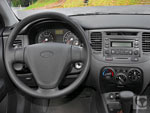 Did you know that "Kia" was derived from a Chinese word meaning "to arise"? Well, here are some of the more memorable one-liners about the first-generation Kia Rio from owners at CarSurvey.org: "I'd rather take my bike to work." "The definition of LEMON." "Does not start, otherwise is OK." "A piece of crap on wheels." This would be an opportune time for the arising to commence.
Did you know that "Kia" was derived from a Chinese word meaning "to arise"? Well, here are some of the more memorable one-liners about the first-generation Kia Rio from owners at CarSurvey.org: "I'd rather take my bike to work." "The definition of LEMON." "Does not start, otherwise is OK." "A piece of crap on wheels." This would be an opportune time for the arising to commence.There's reason to believe it will. As you know, Hyundai just won't halt with the home-runs these days, bringing us one quite decent car after another, each the receptor of more critical acclaim than the last. What does Kia have to do with Hyundai? Simple: Kia is Hyundai. True, the ownership was in place before even the first Kia Rio was born, but partnerships take time to produce offspring.
Time has now passed, and 2006 marks the second year in which a pair of Hyundai-Kia twins share a birthdate. This time, instead of again aiming for the dubious honor of being the cheapest car in America, this tiny twosome continues working from the bottom to push their respective brands upscale. They arrive on an updated platform with slightly larger dimensions, the most claimed power and passenger space in the segment, and an impressive set of six airbags.
Best yet, the Rio's price has only kia-ed up enough to make it the second-least expensive car in America.
Road Test

A few years ago I sampled a Kia Sephia at a public driving event. After taking my turn, I asked the host if he realized that some pranksters had switched his demo car with an 87 Yugo.
Alas, the joke was on me. Apparently it really is possible for a 21st century automobile to combine a lawn mower's growl, a tractor's handling, a pedestrian's passing power, and achieve total frame-and-wheel separation over bumps. Wow, this is the bottom. I felt almost smug as I drove away later that day in my suddenly sumptuous Sentra.
But if the Rio's any clue, we don't have Kia to kick around anymore. Once you get past the non-descript manner in which the engine fires to life, it hits you that this car moves about with a reasonable degree of grace and solidity. Accelerate and you'll notice a well-sprung pedal, a proper engine note, and well-timed transmission transitions. Turn some corners and you'll even feel a trace of the road. There are no shivers, no squeaks or rattles, and no other such obvious reminders of the Rio's price. Ten minutes in and you only feel basic goodness. It's still there after an hour. Then a day.
Yes, performance is humble. Even with only 2,403 pounds to pull around, there's only so much 110 horsepower can do, and the disproportionate level of thrashy engine noise relative to actual movement highlights the modesty. But "modest" is not a euphemism for "intolerable"; as long as you don't mind bumping down to second gear a bunch of times in a day, the Rio won't embarrass you in traffic. And for whatever pride can be found in this statistic, 110 happens to be 7 more horses than in the Scion xA or Chevy Aveo found in their stables.
And what you giveth in speed, you get backeth in gas mileage. In mostly freeway driving, this rational Rio employed Hyundai's new "Theta" engine to return a 30 MPG average - right in line with expectations, given our Scion xA's 31. Our Civic disgraced both with 33, which Kia might have beaten had they opted to break ground and offer the first subcompact car with cruise control. Alas, the ground remains intact.
But there's more to this economy car than just economy. It's actually almost kind of fun to drive. The Rio's light weight is the obvious kick-start; the revvy valve timing-enhanced twin-cam engine keeps it going, and the handling's the cincher. Those 14-inch wheels aren't the pushovers they appear to be, making this one of a treasured few Korean cars with decent tire grip. Better yet, Kia did break some ground by offering the Rio with 4-wheel-disc brakes as long as you order the antilock option - quite a deal for $400. And more on safety: those of you buying a Rio for your rookie-driver teenager can rest easy knowing the Rio's rear end never breaks loose in quick maneuvers. That's one benefit to omitting a rear stabilizer bar.
Speaking of suspensions, the Rio's typical-for-the-class front struts (with stabilizer bar) and semi-independent torsion-beam rear promise a mediocre ride. Sure, most bumps are felt and there's occasional rear-end hammering, but the Rio's ride is right around the Honda standard. More relevantly, it proved much more forgiving than the Scion xA. Despite the car's thin skin, it's not all that noisy, either.
The area most in need of refinement is the steering. It's an inconsistent piece of work that inserts erratic little spikes of effort at random steering angles at random times - quirks that a twisty road really brings to the surface. The culprit probably isn't torque steer (which would require... you know... torque), so it probably has something to do with engine speed-sensitive variable assist being too sensitive, especially considering the car steers fine when coasting along in Neutral. In any case, it feels geeky. But it's not that bad.
Even with the weird steering, the Kia Rio feels 95% as well-engineered as a Scion xA. Put another way, it's now amazingly average.
Inside & Out

Justifying this car's looks just takes an iota of imagination. Those plastic-covered steel wheels aren't cheap; they're durable. Turned off by the black plastic ribbing that mar the Rio's lines? Hey, that's Kia's sporty two-tone paint scheme. And if the rest kind of looks like a Toyota Echo, well, at least they don't make those anymore.
If it's what's on the inside that counts, the new Rio gives a lot more counting to do. Any space increase in a subcompact is welcome, and in fact, the Rio's increases in width (0.8 inches), height (0.8), and wheelbase (3.5) were enough to boost interior volume to 104.1 cubic feet, kicking it up to the compact class right along more expensive cars. Kia proudly boasts that the 92.2 feet of passenger space gives it roomier seating than the Civic and Corolla - quite an achievement considering the Rio's markedly shorter 166.9-inch length.
Truthfully, the Rio still feels one size more snug on the inside. When seated in front, the side glass seems close to your cheeks, and in back, most legs stand but an inch away from the front seatbacks despite the not-bad legroom figure of 34.3 inches. But the seats' design makes for the real surprise: the high-standing rear bench has good butt support, good foot space, a good angle, two adjustable head restraints, and three 3-point belts - all rarities at this size and price. As long as back passengers aren't tall at all, they shall survive.
The front seats are substantial enough for comfort and the driver gets a height adjuster. Two points need attention: the armrest swings to a too-low position (why not get rid of it and throw in a center console?), and the seatback doesn't recline upright enough, cursing the Rio with the same arms-out driving position as the Scion. This test car also had a defective right-side seatbelt anchor that wouldn't adjust for height.
I don't think anyone would mind if Kia had hired one interior decorator. The acres of crappy plastic are acceptable at the price, but only the most style-blind individuals could find satisfaction in this monochromatic all-gray hell. The geometrically-incorrect shapes scattered all over the steering wheel and dash are pretty repulsive to the eye, too. Today's nugget of wisdom: good taste doesn't cost money.
But effort shows in other places. Any object that moves does so with a precise, solid motion. The controls are easy to reach and well-arranged, and the warning chime emits a pleasant DING! We've got variable intermittent wipers, two trip odometers, two dome lights, three grab handles, and don't forget those six airbags - two front, two side, two full-length curtains (the passenger's is auto-sensing) - which set the Rio (and Accent) apart from the other $15,000 cars, and quite a few $20,000 and $25,000 cars as well.
Don't forget that stereo, either, an unexpected highlight. Once you adjust the bass and treble up a few notches (there's even a midrange setting and 4-way graphic equalizer), the 172 impressive watts of power flow cleanly through the Rio's six speakers and reproduce music quite faithfully. Wasn't it just yesterday that cars in this class skimped by with 60 watts and a tape deck? However, spotty reception means static sets in even when the signal is strong.
Trunk space of 11.9 cubic feet is at least average for this class; the back seats fold down easily.
Other Thoughts

Only one car in America now carries a four-digit price tag, and its name is Chevy Aveo. Still, the Rio comes close enough at $11,110 for the stripper stick model (so would the Aveo with comparable equipment). You may be able to live without power windows, power locks, power mirrors, keyless entry, a radio, a tilt steering column, and a folding back seat, but how about power steering? Also, can you drive a stick?
Didn't think so, which takes us to the Rio LX - $12,985 for manual, $13,835 for automatic - filling in all the blanks and bringing it up to par with more expensive cars in every way aside from the unavailability of cruise control, a sunroof, and alloy wheels. You'll want the $600 Power Package (windows, mirrors, locks, plus the two speakers) and the $400 antilock brakes that also change the rear brakes from 8-inch drums to 10.3-inch discs. Floor mats for $70? Ah, why not. If you pass on the only remaining option, the $250 spoiler, you can drive off in a loaded-up Rio LX automatic for $14,835.
There's also the wagon, which changed its name from Rio Cinco to Rio 5 and can hold 49.6 cubic feet of stuff in its hatch. A price of $14,040 / $14,890 puts it $1,055 above the four-door Rio - a pretty stiff penalty even after factoring in the 15-inch alloy wheels, fog lights, rear wiper, leather steering wheel, and metal trim and pedals.
By the way, that "poor man's Hyundai" line was no joke; a Hyundai Accent automatic with all the same options commands $15,410 - a groundless $575 premium. Getting back to their hometown Korean rival, the Chevrolet Aveo LT goes for $14,765 with the same equipment. And that Japanese bully, the Scion xA? $14,770 - and Scion's pricing structure makes that non-negotiable. So the Rio's a real deal.
As mentioned, the Rio is now neck and neck with the xA in engineering and accommodations. In reliability, Kia fights the xA's Toyota invincibility with the world's best warranty: 5 years / 60K miles, 10 years / 100K miles on the powertrain. That makes money the big question (in this class, isn't it always?), and once again the winner is unclear: Scion's likely resale value advantage gets offset by the Rio's lower out-the-door price. [source : automotive.com]
Post a Comment